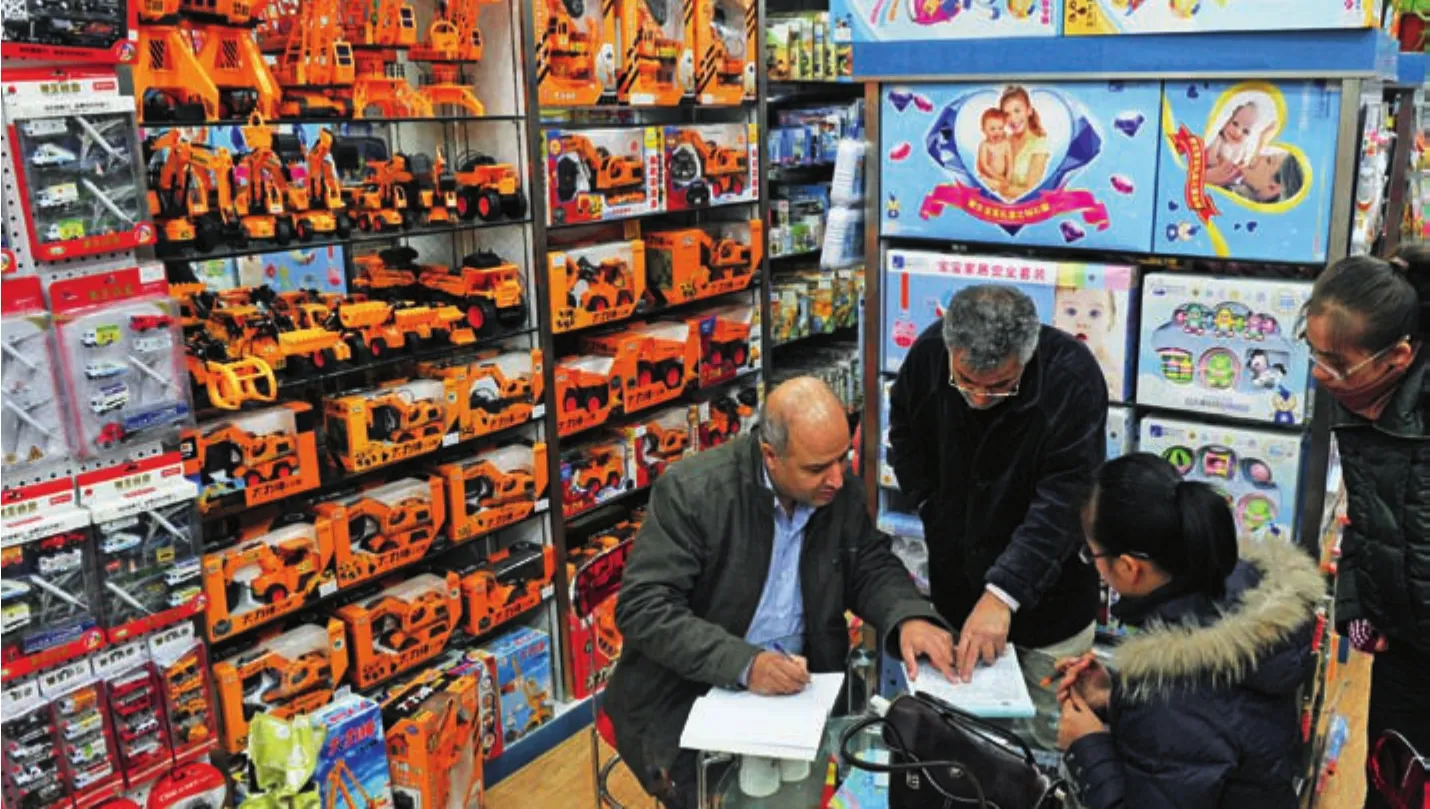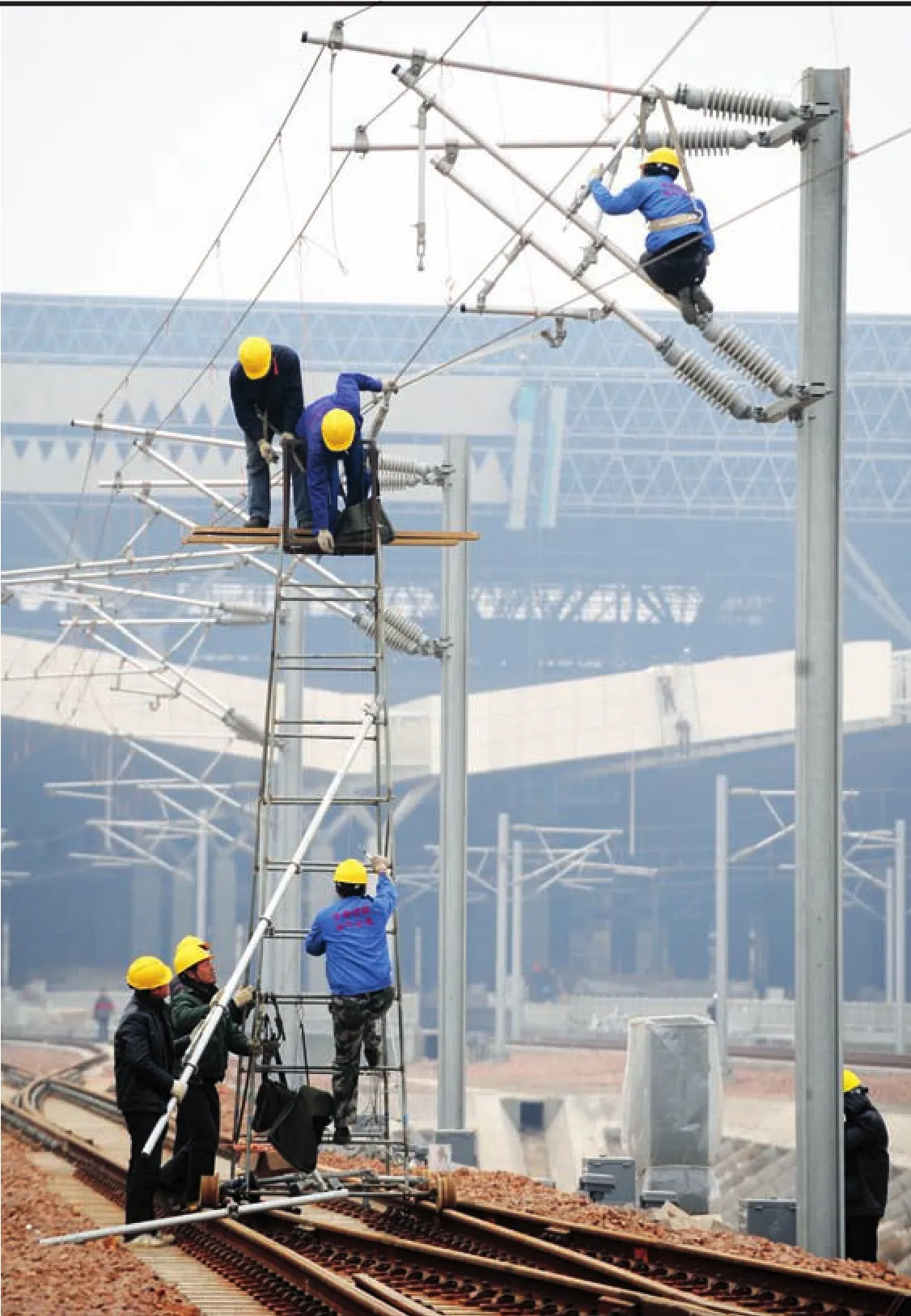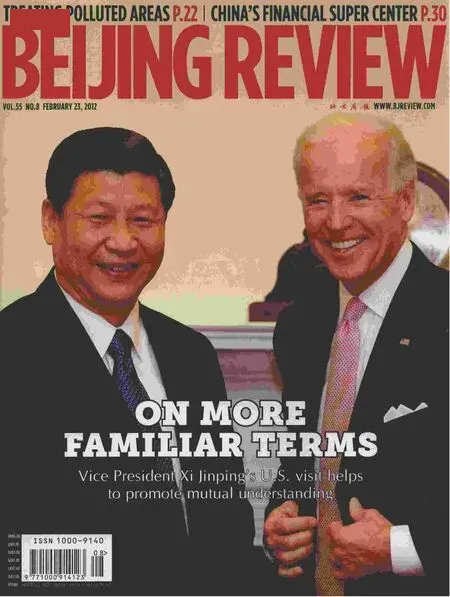In Fora Bumpy Ride
By Hu Yue
In Fora Bumpy Ride
By Hu Yue
The IMF anticipates a number of opportunities and risks facing the Chinese economy

EXPORT WOES: Foreign businessmen p lace orders at a toy shop in Yiwu, Zhejiang Province, which is China’s largest petty comm odities market. The IMF cautioned that China’s export m arket may slum p in a worst-case scenario o f the European debt c risis
C hina’s economy is slow ing, but remains a bright spot in an unpredictable global economy, said the International Monetary Fund (IMF) in its latestChina Economic Outlook.
The IMF expects China’s GDP to grow 8.25 percent in 2012, gathering speed in the latter part of the year and climbing to 8.75 percent in 2013.
“The Chinese economy has, once again,shown its resilience in the m idst of a difficult external environment, buoyed by robust corporate profitability and rising household incomes,” said the report. “However, net exports will prove to be a significant drag on grow th in the com ing two years.”
If European debt woes continue to deteriorate, China will feel the impact mainly through trade, w ith moderate effects on domestic demand. In a worst-case scenario, China’s growth would fall by around 4 percentage points as a result of Europe’s growing problems. “The risks to China from Europe are large and tangible,”said Murtaza Syed, resident representative of the IMF’s Beijing office, at a seminar on February 6.
China’s economy is unlikely to experience a hard landing, and the nation has the capacity to boost fiscal spending, said Anoop Singh, IMF Director for Asia and the Pacific,at a news conference. China can move away from its reliance on external demand and needs to build up domestic demand.
The purchasing managers index (PM I), a barometer of the country’s manufacturing activity,rebounded to 50.5 percent in January 2012 from 50.3 percent in December 2011, a sign that the grow th engine has regained a solid footing.
Un tigh ten ing?
The IMF suggested that China’s monetary policies should be ad justed to allow for a modest addition of credit into the economy.
Over the next couple of months, liquidity conditions need to be fine-tuned through open market operations. However, if foreign capital flows remain subdued, reserve requirements could also be lowered, said the report. The ongoing decline in inflation should be viewed as an opportunity to raise real loan and deposit rates in order to move the cost of capital closer to equilibrium and increase household financial income.
At last year’s Central Economic Work Conference, policymakers pledged to make monetary policies more “targeted, flexible and foresighted.” In November 2011, the People’s Bank of China announced to cut the reserve requirement ratio by 0.5 percentage points for the fi rst time in three years. This was widely seen as a signal for a shift in focus toward pro-grow th policies.
But econom ists are divided about whether China is making a drastic enough sw itch to broader monetary easing.
W ang Tao, an econom ist at the UBS,w rote in a research note that the policy objective has clearly changed to support grow th, as indicated by a rebound in bank lending at the end of 2011.
“In 2012, we expect the government to increase bank lending by at least 8 trillion yuan ($1.27 trillion), likely to be supported by two or three additional cuts of the reserve requirement ratios (for lenders),” she said.
But Fan Wei, an analyst with the Beijingbased Hongyuan Securities Co. L td.,disagreed.
“Full-fledged monetary easing is less likely as China’s reliance on exports is less than it was during the 2008-09 downturn,” he said.
In addition, real inflation may be even worse than what the CPI data suggested,prompting policymakers to take a more neutral policy, said Fan.

INVESTMENT CONCERN: The construction site of the elec trification p ro ject of Zhengzhou East Railway Station.The IMF raised w orries that overdependence on investm ents m ay underm ine China’s grow th m om entum
Mod e l transfo rm ation
China’s efforts to rebalance the economy to rely more on domestic demand are draw ing worldwide attention.
“The weak external outlook underscores the importance of accelerating the transformation of China’s economy to reduce its vulnerability to the vagaries of global demand,” said the IMF report.
China has taken a number of encouraging steps, including appreciating the yuan, making substantial investments to the social safety net,expanding pension and health care coverage,raising the minimum wage, and beginning to raise the cost of inputs to production, it said.Greater efforts are now needed to raise household income and shift the grow th structure from exports and investments toward consumption.
Policy incentives to boost residents’ income are already in the pipeline. Last year,the country raised the cut-off point for personal income tax to 3,500 yuan ($556) from 2,000 yuan ($317). Moreover, the M inistry of Human Resources and Social Security recently announced that the country w ill increase the basic pension of retired enterprise employees by 10 percent in 2012, the seventh consecutive year of hikes since 2005.
At the recently concluded National Finance Work Conference, Xie Xuren, M inister of Finance, said China w ill continue fiscal measures to boost job creation, support needy groups in education, housing and health care, as well as control consumer prices at a reasonable level.
“The key is to foster entrepreneurship,smaller private firm s, elim inate industry monopolies and bridge the w idening wealth gap,” said Li Yining, a professor of economics of the Peking University.
“In order to lift the income of farmers, the country should help improve added value of agricultural products, strengthen job trainings of rural residents and encourage them to start up their own businesses,” said Li.
Daun ting cha llenges
Despite a rosy near-term prospect, the IMF struck a note of caution about lingering risks facing the Chinese economy.
“The biggest concern would be a coinciding, self-reinforcing slump in both the trade and property sectors. This could precipitate a steeper-than-anticipated decline in prices,sales volumes and property-related investment,” said the IMF report.
Stephen Green, chief Asia economist w ith the Standard Chartered Bank, warned that real estate may be the biggest risk to China in 2012.
House prices may continue to drop, and the government is likely to take measures in the second quarter to stabilize the property market, he said.
As the property market cools, buyers are hesitant to jump from the sidelines as expectations of further price dips remain high.Property developers also received a heavy blow, w ith their sales shrinking and balance sheet weakening.
“The appropriate response would be to boost property demand through the government purchasing homes directly for social housing purposes and selectively relaxing some of the adm inistrative purchase restrictions for first-time buyers, low er-income groups and those seeking to buy social housing,” said the report.
China’s over-dependence on investment was also considered a potential source of dangers. “Continuation of the current high levels of investment may, over time, undermine bank and corporate balance sheets,” said the IMF.
Zhang Monan, a researcher w ith the State Information Center, said excessive investments may exacerbate the problem of overcapacity.
Enterprises would have to absorb the over-capacity by strengthening exports, thus complicating the country’s efforts to rebalance the economy, she said.
As they aggressively push forward w ith massive investments, local governments have raised a pile of debts, which sowed the seeds of financial risks, said Zhang.
The country’s local government debts totaled a dizzying 10.7 trillion yuan ($1.7 trillion) by the end of 2010, according to data from the National Audit Office.
It is imperative now for China to curb the government’s preference for investments,focus spending on public welfare, and encourage private investment, she said.

